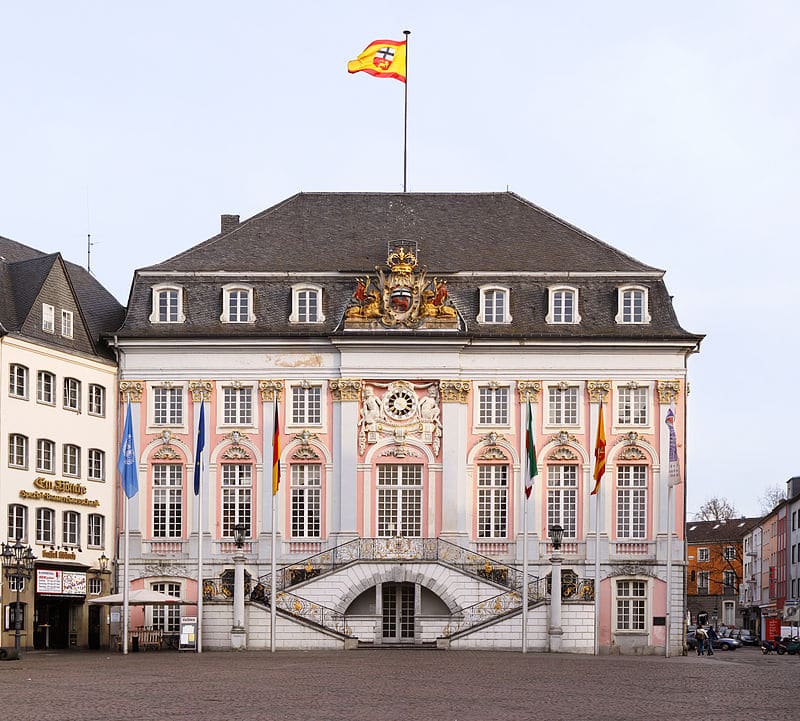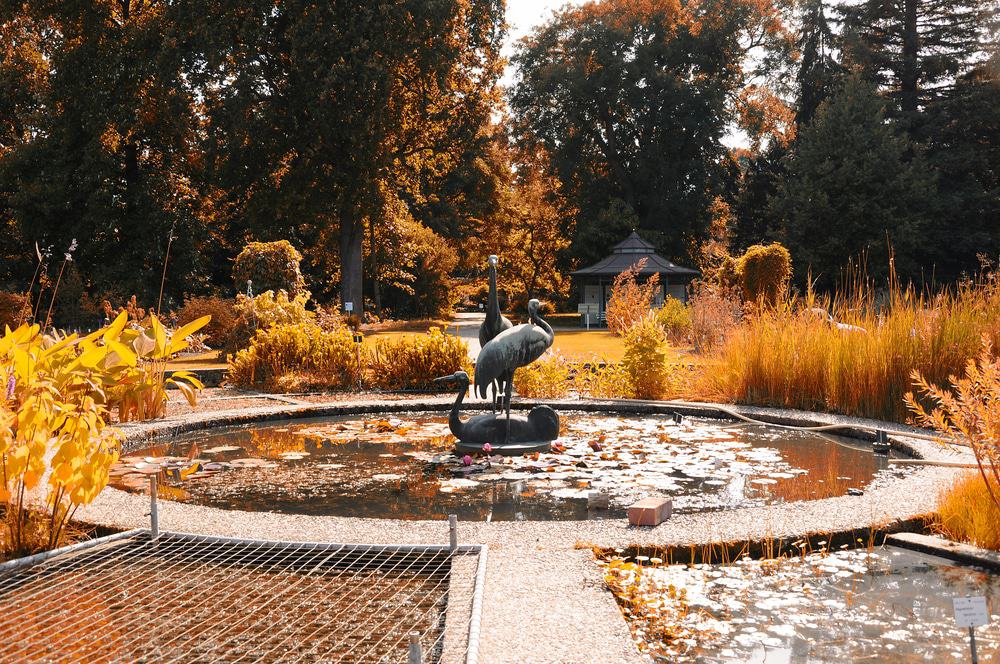On the Middle Rhine, Bonn is a city that everyone knows for being the capital of West Germany up to 1990. Germany’s current constitution was declared in Bonn in 1949 and many government ministries are still located in the city.
Bonn has all the culture of a nation’s capital, not least on its Museum Mile, which has an excellent museum about German contemporary history and the Bundeskunsthalle, one of the country’s top exhibition venues. Bonn was also where the composer Ludwig van Beethoven was born and grew up, and his birthplace and childhood home have been kept as a museum full of invaluable memorabilia from his life.
Let’s explore the best things to do in Bonn:
1. Haus der Geschichte
 Source: Esther Westerveld / flickr
Source: Esther Westerveld / flickrThis museum is a complete summary of contemporary German history, from the end of the Second World War to the present.
You can see what it’s like to attend a Bundestag debate, journey back to the 1950s at the museum’s antique cinema, and get eye-witness accounts of the student unrest of the 60s and 70s and the fall of the Berlin wall.
There are also perspectives on Reunification and globalisation, and since the museum is contemporary the exhibits are refreshed by the year.
Underground you can view the first post-war Chancellor Konrad Adenauer’s service Mercedes and the official railway saloon car that was used by the chancellors up to the 80s.
When the museum was being built in the 1980s workers struck upon a Roman workshop from the 2nd Century, and this was excavated and then adapted as an exhibit in the basement.
2. Beethoven House
 Source: jorisvo / Shutterstock.com
Source: jorisvo / Shutterstock.comEven if you only have a passing interest in classical music you’ll know something about Ludwig van Beethoven.
And the house at Bonngasse 20 is where one of the giants of European culture was born in 1770. The museum is actually an annexe of two buildings; the street-front facade and the building round the back in which Beethoven was born and grew up.
In low-ceilinged rooms at the back are captivating artefacts from his time in Bonn up to 1792, like his baptism entry, original portraits of his family and the Electors of the period who employed him, and personal greeting cards he received.
The front building meanwhile delves into his move to Vienna, and has hand-written sheet music, instruments played by Beethoven, ear trumpets for his deafness and even his death mask.
3. Kunstmuseum Bonn
 Source: kunstmuseum-bonn
Source: kunstmuseum-bonnThe city’s fine arts museum was established after the war and is dedicated to 20th-century art.
You can peruse the largest collection of Rhenish Expressionism in the world, paying special attention to the career of August Macke, one of the founders of Der Blaue Reiter.
There’s also an emphasis on post-War German art by the likes of Georg Baselitz, Blinky Palermo and Hanne Darboven.
The Kunstmuseum has three whole rooms for Joseph Beuys, whose work also comprises a big share of the museum’s collection of more than 5,000 prints.
On top of all this there’s video art to check out by pioneers of the field like Joan Jonas, Dennis Oppenheim and Klaus von Bruch.
4. Bundeskunsthalle
 Source: DLR German Aerospace Center / flickr
Source: DLR German Aerospace Center / flickrOn the Museum Mile, right next to the Kunstmuseum is one of the most visited cultural attractions in the country.
The Bundeskunsthalle is an exhibition centre putting on world-beating temporary shows in the fields of art, science, technology and commerce, as well as congresses, concerts, cinema screenings and annual festivals.
Just to give you a taste of what goes on, there are up to ten exhibitions at any one time, and recent subjects have been Bauhaus, the acclaimed dance director Pina Baunsch, fashion designer Karl Lagerfeld, the photographer Juergen Teller and the Swiss Symbolist Ferdinand Hodler.
At the entrance take a moment to see the Kaltes Quadrat (Cold Square), where the artist Tom Fecht has laid cobblestones as a memory for cultural figures like Miles Davis, Michel Foucault, Rock Hudson and Freddie Mercury who lost their lives in the AIDS epidemic.
5. Bonn Minster
 Source: Shutterstock
Source: ShutterstockOne of Germany’s oldest churches, Bonn Minster is a glorious edifice built in the 11th century over ruins of churches and temples that date from Roman times.
Two Holy Roman Emperors, Charles IV and Frederick the Fair were crowned at this spot in the 14th century.
There are five towers, the largest of which is octagonal, and they’re all broken with semi-circular arched windows, which are typical of the Romanesque.
The south side is Germany’s best preserved Romanesque cloister, while the interior has Romanesque and Gothic architecture, with Baroque decoration.
In the apse you can pore over the radiant blue and red windows created by the Expressionist artist Heinrich Campendonk.
6. Altes Rathaus (Old Town Hall)
 Source: wikipedia
Source: wikipediaOn the eastern boundary of Markt (Marketplace) is Bonn’s 18th-century town hall, which still has the mayor’s offices and reception rooms.
This exquisite Rococo building was started in the 1730s and is crowned with a mansard roof and dormer windows, has a twin staircase in front.
If you can remember back to when Bonn was the capital of West Germany, you may have seen this pink and grey facade and staircase during state visits that took place at the Altes Rathaus.
John F. Kennedy, Charles de Gaulle and Mikhail Gorbachev were all received here, to name just three.
7. Rheinisches Landesmuseum Bonn
 Source: wikipedia
Source: wikipediaIn a memorable building surrounded by a glass cube shell, this museum tackles the archaeological cultural and artistic history of the Middle Rhineland.
Seven themed exhibition areas guide you from the days of the Neanderthals to the present day.
The main focus is antiquity and the Bronze Age: Take the Waldalgesheim chariot burial, a hoard of gold rings and a bronze pot from a Celtic grave from 400BC, or the museum’s many steles and busts from the Roman period.
One exhibit you have to see is the Sun God and Zodiac Mosaic, which dates to 270 and is completely intact, showing Sol Invictus driving his chariot across the sky, encircled by signs of the zodiac.
8. Museum Koenig
 Source: Shutterstock
Source: ShutterstockFirst off, the building containing Bonn’s world-class zoology museum witnessed a momentous event in 1948 when the opening session of the FDR’s parliamentary council took place in the atrium.
And as for the museum, it is named after the Bonn-born naturalist Alexander Koenig, who embarked on expeditions to the Arctic and Africa in the 19th century.
The main exhibition “Our Blue Planet – the Living Network” explains intricate ecological systems in a way that kids and grownups can follow.
This uses lifelike dioramas (with some specimens collected by Koenig) of environments like tropical rainforests, polar regions, the African savannah, deserts and Central Europe’s temperate landscapes.
9. Poppelsdorf Palace
 Source: Shutterstock
Source: ShutterstockThe Baroque Poppelsdorf Palace was begun in 1715, right where Poppelsdorf Castle stood until it was flattened during the Cologne War in the 1580s.
The palace is a Baroque treasure intended as a pleasure palace for Joseph Clemens, the Archbishop Elector of Cologne.
For almost 200 years the building and its grounds have been owned by the University of Bonn.
The facade has a French classical design, with quoins, a double stairway and mansard roof.
Make sure to go through to the delightful arcaded central courtyard, which is in an Italianate style on a circular plan.
10. Botanical Garden
 Source: Yulia Melnikova / Shutterstock.com
Source: Yulia Melnikova / Shutterstock.comThe grounds of Poppelsdorf Palace are planted with the University’s botanical collection, arranged in formal beds and bounded by the palace’s moat.
The garden was cultivated throughout the 19th century and by 1900 it was second only to Berlin’s, but was sadly lost in the war.
Since then it has been revived, and now has approximately 8,000 plant species, 700 of which are trees in the arboretum.
The garden has five large greenhouses supporting subtropical ferns, rainforest species, Mediterranean plants, cactuses and while the Victoria House shelters a pond growing giant water lilies and other tropical wetland plant-life.
Bring a sense of curiosity as there are smaller conservatories around the garden for orchids and carnivorous species.
11. Münsterplatz
 Source: Shutterstock
Source: ShutterstockThe square in front of Bonn Minster is the biggest in Bonn’s city centre, and that church isn’t the only worthwhile sight here.
You have to stop here for a photo of the Beethoven Monument, which was drawn up by Ernst Hähnel and executed by Jacob Daniel Burgschmiet in 1845. The statue was unveiled to a festival, directed by Franz Liszt, that went on for a number of days.
At the base of the monument are four allegorical representations of the types of music Beethoven composed.
Münsterplatz is also the music stage for the annual Bonn-Fest in autumn, and is decked with stalls every December for the Christmas market.
12. Alter Zoll
 Source: Rubén Vique / flickr
Source: Rubén Vique / flickrOn the left bank of the Rhine you can climb up to a terrace on the Alter Zoll, which was a bastion in the city’s fortifications.
At this height there’s a fine view of the Rhine, and the cannons are a reminder of the structure’s former defensive purpose.
In the distance to the southeast you can make out the Siebengebirge, a range of volcanic hills.
There’s also a lot of public art and monuments around the bastion, like the statue for the writer Ernst Moritz Arndt and an abstract memorial for the Romantic poet Heinrich Heine by Ulrich Rückriem.
A little way along from the bastion is a biergarten also making the most of those picturesque panoramas from the ramparts.
13. Schloss Drachenburg
 Source: Shutterstock
Source: ShutterstockA few minutes up the Rhine there’s a fairytale Gothic Revival castle high on the Drachenfells hill over the right bank of the river.
A rack railway, the Drachenfelsbahn, lifts you up from the resort of Königswinter.
This romantic muddle of towers and spires was completed in just two years up to 1884 as an ostentatious residence for the banker Stephan von Sarter.
He never chose to live in Schloss Drachenburg, and after he passed away the castle was put to a variety of uses before gaining protection as a monument.
The interior is decorated with Baroque-style frescoes, carved wooden panels, ornamented vaults and stained glass , and you can scale the main tower to contemplate the Rhine.
The hilly grounds are on the European Garden Heritage Network, and are navigated via stairways and bursting with sculptures.
14. Arithmeum
 Source: commons.wikimedia
Source: commons.wikimediaManaged by the University of Bonn, the Arithmeum is a science and technology museum specialising in mathematics.
The founder was the director of the Research Institute for Discrete Mathematics at the university, Bernhard Korte who donated his own collection of adding machines.
There are now 4,500 adding machines, 800 works of art, 2,000 books and 500 historic computers.
The permanent exhibition takes on a chronology of machine arithmetic, from abacuses to sophisticated tools like the Enigma cipher machine from the Second World War.
Also in the exhibition is Herman Holleroth’s trailblazing punched card tabulator from the 1890s.
15. Wildpark Venusberg
 Source: tripadvisor
Source: tripadvisorOn the southern slope of the Venusberg hill in the south of Bonn lies the Waldau forest, much loved for its animal habitats that you can visit on a woodland path.
You’ll see wild boars, fallow deer and red deer in forest clearings.
The attraction also has an information centre revealing the ecology of the wider Kottenforst which unfolds over 40 square kilometres south of Bonn.
Outside there’s a kitchen garden growing vegetables and herbs, an adventure playground and a cafe for a bit of refreshment after your walk.
If you’re up for a longer walk in the Kottenforst there’s another handy entry point at Bahnhof Kottenforst on the S-Bahn.
